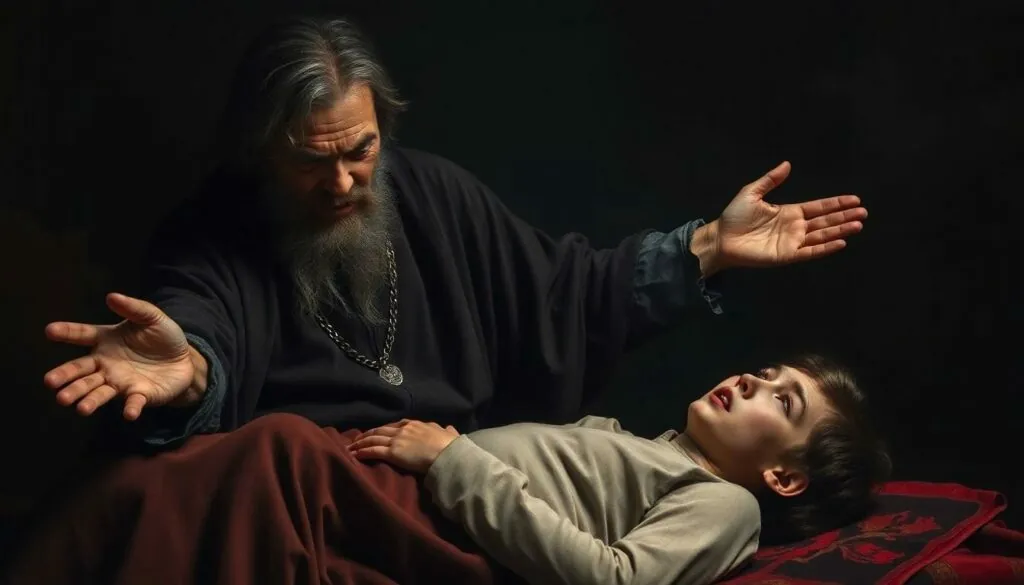Table of Contents
ToggleIn the realm of art history, few pieces spark as much intrigue as the haunting portrayal of Ivan the Terrible and his son. This dramatic painting captures a moment of raw emotion, blending tragedy with a touch of the macabre that keeps viewers coming back for more. It’s not just a painting; it’s a window into the chaotic world of 16th-century Russia, where power struggles and family drama were the order of the day.
Imagine a scene so intense it could make a soap opera look like a light-hearted comedy. The artist, Ilya Repin, didn’t just paint; he crafted a narrative that resonates with anyone who’s ever had a family dispute—albeit on a slightly more extreme scale. Dive into the story behind this captivating artwork and discover why it remains a conversation starter in galleries and living rooms alike.
Overview of Ivan The Terrible Son Painting
“Ivan the Terrible and His Son” created by Ilya Repin portrays a pivotal moment in Russian history. This painting reflects a father’s deep despair after unintentionally killing his son, demonstrating the intense emotions surrounding familial relationships. The work captures the raw, chaotic energy of the moment, emphasizing the tragic nature of power and responsibility.
Rich colors enhance the emotional depth within the piece. Dark hues dominate, creating a somber atmosphere that aligns with the themes of sorrow and regret. Contrastingly, lighter shades highlight the figures, drawing viewers’ attention directly to Ivan and his son.
The composition showcases intricate details that reveal the skill of Repin as an artist. Both figures exhibit expressions of horror and grief, encapsulating the devastating consequences of violent power struggles during the 16th century. Surrounding elements in the painting serve to amplify the emotional impact, underscoring the feeling of loss.
Art historians often analyze the painting’s significance in relation to Ivan IV’s turbulent reign. Contextualizing the artwork within its historical framework provides insight into the broader implications of Ivan’s actions. Such interpretations make the painting a frequent subject in academic discussions.
Many exhibitions include this artwork due to its profound narrative. Its psychological depth captivates audiences, inviting them to reflect on themes of tragedy and familial bonds. “Ivan the Terrible and His Son” remains a timeless exploration of human emotion amid the complexities of power.
Historical Context

The painting “Ivan the Terrible and His Son” reflects the intense social and political upheaval of 16th-century Russia. It captures a tragic moment that resonates with the historical significance of its subject matter.
Background of Ivan The Terrible
Ivan IV, known as Ivan the Terrible, reigned from 1547 to 1584 and became the first Tsar of Russia. He centralized power amidst struggles among the nobility and faced significant opposition. Ivan introduced reforms but ruled with an iron fist, leading to turmoil and violence. His reign included the Oprichnina, a campaign of political repression. These actions created a legacy marked by both unification and brutality. Ultimately, his complex persona shaped Russia’s future and influenced many historical interpretations.
Artistic Movements of the Era
During the 19th century, realism emerged as a significant artistic movement. It focused on depicting everyday life and human emotions authentically. Artists, including Ilya Repin, sought to present their subjects with honesty and depth. Repin’s work embodies this movement, emphasizing psychological nuance and emotional intensity. The era also saw an interest in national identity, where artworks reflected cultural narratives and historical themes. Through his painting, Repin engaged with these ideas, offering a perspective on Ivan IV’s personal and political struggles.
Analysis of the Painting
The painting “Ivan the Terrible and His Son” offers a profound exploration of power and emotion. Repin’s technique captivates viewers through its intricate details and compelling composition.
Composition and Technique
Dynamic positioning characterizes the composition, creating a strong emotional impact. Ivan’s posture conveys despair, with a hunched body language highlighting grief. The background remains a blur, drawing attention to the figures instead of distracting from them. Each element strategically supports the narrative, enhancing viewer engagement. Skillful use of light and shadow illustrates tension amidst despair, revealing Repin’s mastery of realism.
Color Palette and Symbolism
The color palette employs rich, dark hues to underscore the somber mood of the scene. Deep reds evoke bloodshed and violence, while muted greens suggest the decay of familial bonds. Lighter shades around the figures accentuate their expressions, directing focus to their emotional turmoil. Symbolic colors in the artwork reflect the inner conflicts faced by Ivan. The vibrancy of the palette reveals underlying themes of tragedy, responsibility, and the consequences of power.
Artist Profile
Ilya Repin stands out as one of Russia’s most prominent painters, known for his ability to convey intense human emotions through art. Active during the 19th century, he played a significant role in the realism movement.
Biography of Ilya Repin
Born on August 5, 1844, in Chuguev, Ukraine, Repin’s artistic journey began early. He studied at the Imperial Academy of Arts in St. Petersburg, where his talent flourished. By 1869, he achieved recognition for his masterpiece “Barge Haulers on the Volga.” This painting showcased his ability to portray the struggles of the lower class. Throughout his career, Repin created various works that explored Russian culture and history. His paintings addressed complex social issues and emotional depth, earning him accolades. Repin passed away on September 29, 1930, leaving a lasting legacy in the world of art.
Influences on Repin’s Work
Repin’s artistic development drew from various influences. The realism movement profoundly shaped his approach, emphasizing authenticity and emotional expression. He also found inspiration in contemporary Russian life and history, seeking to depict real human experiences. His encounters with European masters, including Velázquez and Rembrandt, informed his use of light and shadow. Additionally, Russian folk art and traditions significantly impacted his style. Themes of suffering and national identity are prevalent in his work, reflecting broader societal issues. Through these influences, Repin crafted pieces that resonate deeply with audiences, blending historical narrative with emotional intensity.
Reception and Legacy
The painting “Ivan the Terrible and His Son” received a varied reception, attracting both admiration and criticism. Viewers were struck by its raw emotional power, which resonated deeply due to the tragic narrative it conveyed. Critics initially expressed concerns about the grisly subject matter, yet many acknowledged Repin’s technical skill. The emotional intensity prompted discussions on themes like power and guilt, illustrating the painting’s capacity to evoke strong reactions.
Initial Public Reaction
Initial public reactions highlighted the shock and intrigue surrounding the work. Art enthusiasts appreciated the vivid portrayal of despair, while others found the depiction of violence unsettling. The painting ignited conversations about moral responsibility and the nature of authority, making it a focal point in art discussions. Audiences marveled at Repin’s ability to encapsulate a pivotal moment in Russian history, leading to extensive debates in galleries and salons.
Influence on Future Art
The influence of “Ivan the Terrible and His Son” extends into modern art, impacting various artists and movements. Its exploration of human emotion encouraged a more expressive approach to narrative painting. Many contemporary artists draw inspiration from Repin’s techniques, emphasizing emotional depth in their work. The painting’s legacy lies in its ability to blend historical context with psychological insight, setting a precedent for emotional storytelling in art.
“Ivan the Terrible and His Son” stands as a powerful testament to the complexities of human emotion and the weight of authority. Repin’s masterful technique and emotional depth create a haunting narrative that continues to resonate with audiences today. The painting not only reflects the tumultuous history of Russia but also invites viewers to contemplate the moral dilemmas surrounding power and responsibility.
As discussions around this iconic piece evolve, it remains a crucial part of the art world. Its influence on contemporary artists highlights the enduring relevance of Repin’s work. By engaging with themes of tragedy and familial conflict, “Ivan the Terrible and His Son” ensures its place in both historical and modern artistic discourse.







